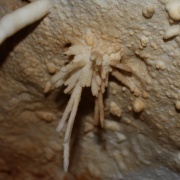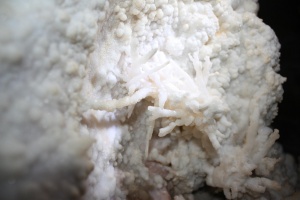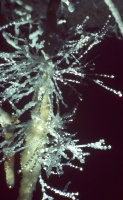Aragonite (Inventory)/Anthodite
From LagWiki
(→References) |
|||
| Line 24: | Line 24: | ||
<gallery perrow=1 widths=300px heights=200px> | <gallery perrow=1 widths=300px heights=200px> | ||
File:Anthodite 3.jpg|Anthodite | File:Anthodite 3.jpg|Anthodite | ||
| - | File:anthodite.jpg|Anthodite | + | File:anthodite.jpg|Beaded Anthodite |
</gallery> | </gallery> | ||
{{Cave inventory}} | {{Cave inventory}} | ||
Revision as of 01:05, 21 November 2013
Anthodites are clusters of quill-like sprays radiating from a central location.
Anthodites are usually white and resemble a sea urchin. Though in the aragonite section of the inventory form, they are usually composed of calcite but may have aragonite mixed in. Anthodites are hard to classify because they may resemble other speleothems such as antler helictites.
Antler helictites form by capillary or wicking of solutions through a tiny central canal. Anthodites form from thin solutions along the outer surface.
The differences between anthodites, frostwork and helictites, especially antler helictites, are transitional in nature. One may transform into the other and they are often found associated and even mixed together in the same formation. The differences are often subtle and distinctions are sometimes arbitrary. Deciding how to classify one of these types on the inventory form is sometimes subjective and inexact.
In general:
- Anthodites are spiky, like quills, and radiate from a central point.
- Frostwork is fine, needle-like and looks like ice crystals.
- Antler Helictites are more like a deer antler.
A single formation could show qualities of each and it would not be improper to classify it under more than one category, if so.
See also
References
- Hill, Carol; Paolo Forti (1997) Cave Minerals of the World (Second Edition ed.) National Speleological Society pp 45-47 ISBN: 1-879961-07-5



